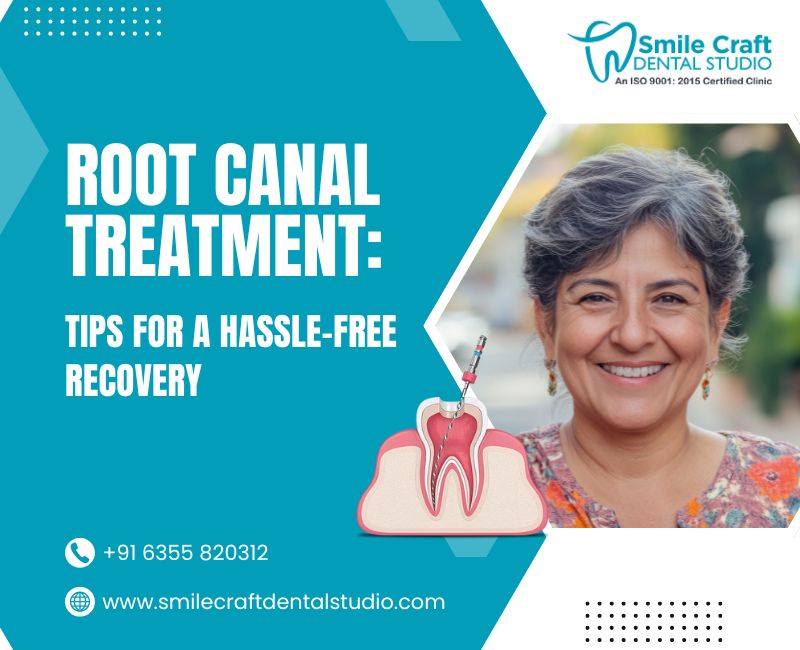Root Canal Treatment: Tips for a Hassle-Free Recovery

You know how women make it a point to visit the parlour every month to stay fresh, and men never skip their trips to the salon to keep looking sharp? Well, your dentist should be right up there on that list! Why? Because regular dental checkups are just as essential for your health as those grooming appointments. Keeping your teeth healthy is just as important as keeping your look fresh. Let’s explore why scheduling that dentist appointment should be as much of a routine as any other self-care habit!
Root Canal Treatment: Tips for a Hassle-Free Recovery
If you’re here, chances are you’ve been told you need a root canal, and now you're probably feeling a bit uneasy about the procedure and recovery. Trust me, you’re not alone! It’s totally normal to feel concerned. But here’s the good news: with the right care, recovery can be pretty smooth, and you’ll return to your regular routine faster than you think. Root canal treatments are one of the best ways to save a tooth that might otherwise have to be pulled. So, let's break it down and make sure your recovery is as easy as possible!
What’s the Deal with Root Canal Treatment?
Before we dive into recovery tips, let’s quickly talk about what a root canal actually involves. When you get a root canal, your dentist removes the damaged or infected tissue (called the pulp) from inside your tooth and then seals it up to prevent further problems. This is often followed by a crown on the tooth to ensure it stays strong and functional.
While the procedure is routine and very effective, some tenderness afterward is normal. But don’t worry! You can minimize the discomfort and heal quickly with the right aftercare.
1. Follow Your Dentist’s Instructions
After your root canal, your dentist will give you specific instructions to help you recover. These might include how to manage swelling, what to eat, and which medications to take. Make sure to follow these carefully. Taking your prescribed pain relievers or antibiotics is key to managing discomfort and preventing infection.
2. A Little Discomfort is Normal
Feeling discomfort or tenderness in the treated area is completely normal. It usually doesn’t last long—just a couple of days at most—so don’t panic! This is mostly due to the inflammation and minor irritation from the procedure itself. If the pain lasts longer than expected or gets worse, give your dentist a call to make sure everything is healing as it should.
For the first 24-48 hours, try to avoid chewing on the side of your mouth where the treatment was done. Giving your tooth some time to settle will help reduce any irritation.
3. Stick to Soft Foods
After the procedure, your tooth might be a little sensitive, so it’s best to eat soft foods for the first few days. Soup, mashed potatoes, yogurt, and smoothies are great choices. Try to avoid anything hard, crunchy, or sticky—those can irritate the treated area and make things uncomfortable. Also, chew on the opposite side of your mouth to avoid putting extra pressure on the treated tooth.
4. No Smoking or Drinking Alcohol
It’s tempting to kick back with a drink or smoke after a procedure like this, but it’s better to hold off for a bit. Smoking can slow down healing by reducing blood flow, and alcohol can interact with your medications. To give your body the best chance to heal, it’s a good idea to skip both for a few days after the treatment.
5. Keep Your Mouth Clean (But Gently)
Keeping your mouth clean is important, but you don’t want to be too rough with your teeth right after the procedure. Brush your teeth like usual, but be extra gentle around the treated tooth. If your dentist placed a temporary filling, avoid brushing directly on it so you don’t accidentally dislodge it. You can also rinse with warm salt water (half a teaspoon of salt in 8 ounces of warm water) to help with healing and keep things clean.
6. Watch for Any Complications
While complications are rare, knowing what to look out for is always good. If you experience sharp or severe pain, notice a change in your bite, or have swelling that doesn’t go away after a few days, reach out to your dentist. If you spot signs of infection—like pus, fever, or a bad taste in your mouth—get in touch with your dentist right away.
7. Don’t Skip Your Follow-Up Appointment
After your root canal, you’ll need a follow-up appointment to ensure everything is healing properly. This is also when your dentist will place a permanent crown over your tooth, so it’s important not to miss this visit. The crown will restore your tooth’s strength and appearance, so make sure it’s part of your recovery plan!
A root canal might sound intimidating, but the recovery process doesn’t have to be! By following your dentist’s instructions and taking good care of yourself, you can have a smooth and relatively quick recovery.
If you’re looking for root canal treatment in Satellite Ahmedabad, Smilecraft Dental Studio is here to help. We’ll guide you through every step to ensure your treatment is successful and your recovery is stress-free!
With the right care, you’ll be smiling again in no time.
